
DAVE LAMBERT'S GUITAR COLLECTION
by Dave Lambert
Over the years, Dave has amassed an impressive collection of guitars - lovingly tended and looked after. He's sent me the following photos and some background on each one of them. Over to you Dave ......
February 2012 update
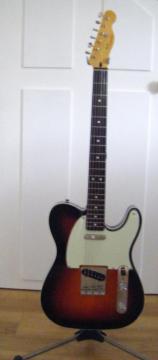 |
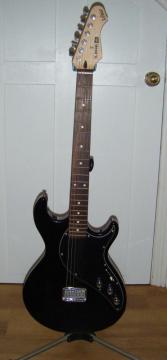 |
Telecaster |
Variax |
The Telecaster is, without doubt, the most iconic shape in electric guitars. It is still, essentially, exactly the same as the Fender Broadcaster which was designed in the '40's. The name Broadcaster had to be changed because Fender were threatened with a law-suit by a company producing a radio with the same name. Leo Fender was aware that television, still in it's infancy, was quickly becoming popular so adopted the name Telecaster.
My 'Tele' is a limited edition Classic Vibe by Fender Squier. It is very lightweight, compared to my Les Paul, and plays extremely well. I was first attracted to it by the double-binding which is the plastic edging around the body. On a single-binding the edging is around the front only, on a double-binding it's back and front.
The Variax is made by Line-6 and is effectively a simulator. It has hundreds of built-in sample sounds and I can download more if I need them. I find it extremely useful in my studio and have used it a lot, with Strawbs, Fire and Zeus, when I'm overdubbing.
The acoustic guitar sounds, 6 and 12 string, are particularly good and the output from the electric sounds is very powerful. It also has a switch to change tunings, so I can be in G, D, C or many other tunings in a second.
It's not the easiest guitar to play, I find it a bit stiff, but it's a very affordable instrument and well worth having if you have a home studio.

September 2005 update
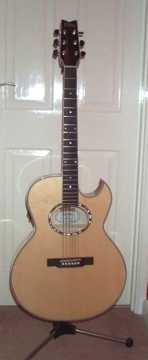 |
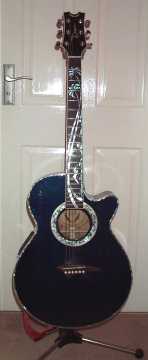 |
Picture 0551 |
Picture 0552 |
Picture 551 The blonde guitar is the one that Washburn kindly supplied me with as a replacement for the smashed Black Washburn. It doesn't appear to have a model name but is identified as an EA20SDL. I've used it on every acoustic show since we came back from the US and although it early to tell (it normally takes two or three months of continual use before you can really say that you've got to know an instrument), so far it feels good. The body is much slimmer than the guitars I've been playing recently, and the sound on this one tends to favour the treble end. I'll probably have a bit of personal tailoring done before too long, to get the strings sitting exactly where I normally have them. I also think that this is a very attractive instrument, I think it's the first blonde that I've owned.
Picture 552 The Dean is a Key Largo Blue Dolphin. This is the guitar that was so generously given to me by Ron Lindeboom in California. My black Washburn was smashed in transit, and Ron presented me with this as a replacement. It plays beautifully and has a very low action. It is also one of the most attractive looking instruments that I've ever seen. The fretboard has no marker dots, and with the elaborate inlay it's just as well. The dots are on the top side of the neck, so I have to look down at the neck instead of at the fretboard to find my place. It has a sound which favours the bass end which I find helpful for rhythm playing.

Original feature
 |
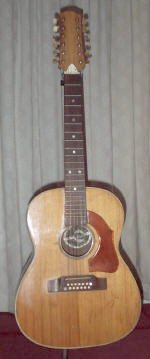 |
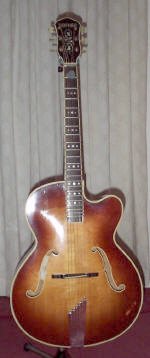 |
Picture 0303 |
Picture 0304 |
Picture 0305 |
Picture 0303. Fender Redondo Flat top and back acoustic U.S. 1969. Bought in Hollywood in 1978 for $150. Small bodied and slim neck. Plays beautifully and was my main stage acoustic for many years.Tony Zematis fitted a transducer pick-up in the early eighties. I'd be interested to hear from anyone who knows the whereabouts of another of these as it appears to be quite rare (although Fender have re-used the name Redondo since). I've now retired it to home use only.
Picture 0304. Hoyer 12 string. Flat top and shaped back. German probably 1950's. Bought in 1982 as salvage for £20. Although Tony Zematis restored the instrument to playing condition, it remains quite delicate. It has a very wide neck which I like in a 12 string and holds tuning well, the fingerboard is flat.
Picture 0305. Hofner President cello bodied acoustic. German 1960. Bought in the mid-nineties for £220. This is a beautiful looking guitar and plays well, it's the only acoustic that I string with acoustic strings, as opposed to the electric strings that I use on my other instruments. I wanted one of these because when I went to guitar lessons in the late 50's, all the bigger boys had them and I was jealous.
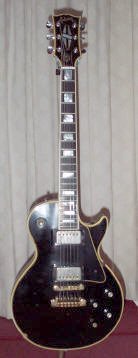 |
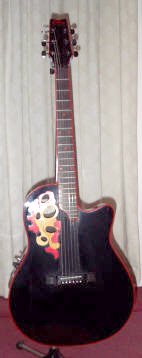 |
Picture 0306 |
Picture 0307 |
Picture 0306. Gold plated Gibson Les Paul Custom. U.S. 1969. Bought in Hounslow in late '73 for £250. I had a new sunburst deluxe when I joined Strawbs in '72 but couldn't get a clean sound , no problem with the dirty sound, but we play a lot of material that requires a clean sound. The Custom will do anything you want it to and remains my favourite electric instrument, my own Black Beauty. It can be heard on all Strawbs albums from, and including, Hero and Heroine.
Picture 0307. Washburn Sundowner cut-away electro-acoustic mid 80's.Bought for £150 in the early nineties. A real bargain and proof that you don't have to spend a fortune for a decent instrument, it is the most reliable electro-acoustic I have used. The whole neck is playable because of the cut-away, which enables me to use it like an electric guitar. Nothing special as an acoustic, but when plugged in, has a terrific response and sound. The only alteration it has to standard is the battery container, which I had moved for easier access. The decoration on the shoulder of the body is in fact a series of sound holes, and there is no central sound hole.
 |
 |
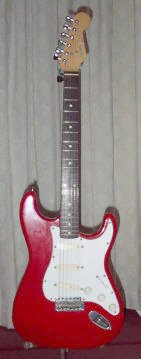 |
Picture 0308 |
Picture 0309 |
Picture 0310 |
Pictures 0308 and 0309. Vox Winchester. Made in England 1967. Bought in Ealing in mid 70's. I don't remember the price but it wasn't a lot, maybe £70 or so. In February 2001 I was invited to a surprise 80th birthday party for Richard 'Dick' Denny, who was the original design technician for Vox. He is responsible for the invention and development of the AC 30 and most of the subsequent amplifiers and gadgets that Vox produced in their major years. I mentioned to him that I had a 1962 AC 10 at home which pleased him, but when I told him about my Winchester guitar his eyes lit up. The pedals Vox were producing at that time were simply not doing very well, Dick was sitting one day with the body of a wah-wah in his hands trying to think of new ideas, his eyes were drawn to a guitar neck lying near his bench and he quite simply put the two components (wah body and guitar neck) together for the heck of it.
The instruments were produced in 1967 only, there were three models; Repeater, Bushwhacker, and Winchester. All three had a different electronic gimmick built in, so as to make some form of gun effect. They were not particularly successful and are consequently extremely rare, in fact I think there were only twelve produced in all. Dick was delighted to know that I have one of these and has promised to send me original photo's and catalogue advertising material. (It may not have been successful but if you look at the design it may remind you of some more modern instruments). I played this guitar on Top of the Pops in late 1973 for Shine On Silver Sun.
Picture 310. A 90's Japanese Fender Squier bought for £160 and acts as my spare. Plays very well, and is further proof that a reasonably priced instrument, well set-up, can be as useful as one at ten times the price. (A good set-up needn't be expensive if you find the right person).



